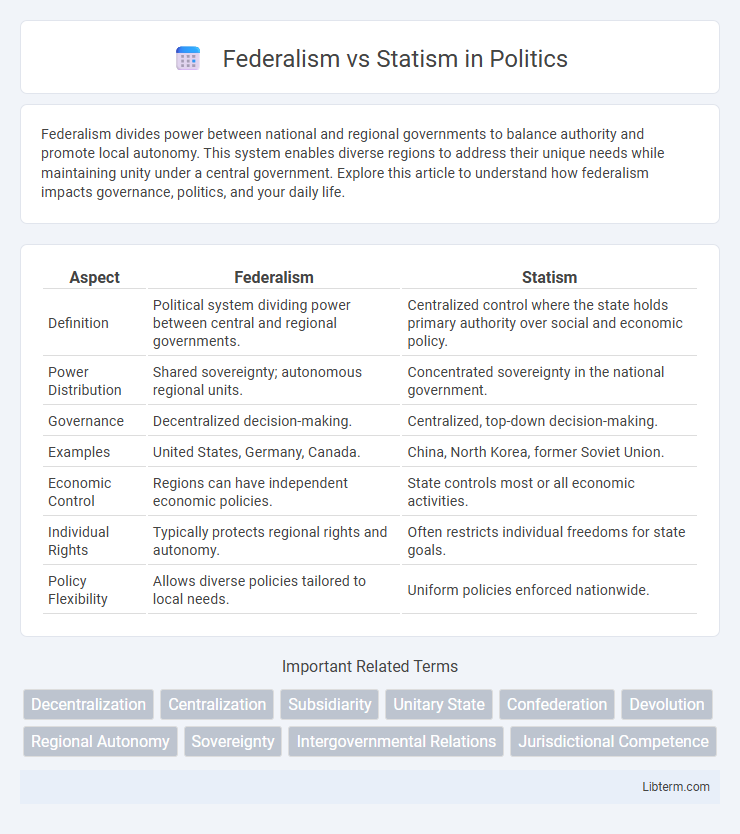Federalism divides power between national and regional governments to balance authority and promote local autonomy. This system enables diverse regions to address their unique needs while maintaining unity under a central government. Explore this article to understand how federalism impacts governance, politics, and your daily life.
Table of Comparison
| Aspect | Federalism | Statism |
|---|---|---|
| Definition | Political system dividing power between central and regional governments. | Centralized control where the state holds primary authority over social and economic policy. |
| Power Distribution | Shared sovereignty; autonomous regional units. | Concentrated sovereignty in the national government. |
| Governance | Decentralized decision-making. | Centralized, top-down decision-making. |
| Examples | United States, Germany, Canada. | China, North Korea, former Soviet Union. |
| Economic Control | Regions can have independent economic policies. | State controls most or all economic activities. |
| Individual Rights | Typically protects regional rights and autonomy. | Often restricts individual freedoms for state goals. |
| Policy Flexibility | Allows diverse policies tailored to local needs. | Uniform policies enforced nationwide. |
Understanding Federalism: Key Principles
Federalism is a political system that divides power between a central government and constituent political units, such as states or provinces, ensuring shared governance and autonomy. Key principles include the decentralization of authority, constitutional division of powers, and protection of local interests within a unified national framework. This structure promotes political diversity, local decision-making, and balance between unity and regional sovereignty.
Defining Statism: Core Characteristics
Statism emphasizes centralized control where the state holds significant authority over political, economic, and social life, often prioritizing government intervention and regulation. Core characteristics include concentration of power in a central government, limited individual autonomy, and prioritization of state objectives over personal freedoms. This approach contrasts with federalism's division of powers across multiple governance levels, highlighting statism's focus on unified policy-making and authority.
Historical Roots of Federalism
The historical roots of federalism trace back to the 18th-century political experiments in the United States and Switzerland, where power was deliberately divided between a central authority and constituent political units to balance authority and liberty. Federalism emerged as a response to the challenges of governing diverse populations and expansive territories, fostering cooperation while preserving local autonomy. This system contrasts with statism, which centralizes power within a singular government entity, often reducing regional self-governance and limiting pluralism.
Evolution of Statism in Modern Nations
Statism in modern nations has evolved through centralization of political authority aimed at achieving economic planning, social control, and national unity. This shift is often characterized by expanding government roles in healthcare, education, and welfare, reflecting a response to industrialization and globalization challenges. The evolution contrasts with federalism by emphasizing strong centralized governance over decentralized regional powers, influencing policy uniformity and state intervention levels.
Power Distribution: Central vs Regional Authority
Federalism allocates power between central and regional authorities, establishing a constitutional division that grants significant autonomy to regional governments while maintaining national unity. Statism centralizes power within a dominant government entity, often limiting regional authorities' independence to enforce uniform policies and control resources. This fundamental distinction shapes governance structures, affecting policy implementation, local autonomy, and citizen representation.
Governance Efficiency: Comparing Systems
Federalism enhances governance efficiency by distributing authority across multiple levels, allowing localized decision-making tailored to regional needs, which reduces bureaucratic bottlenecks and fosters innovation. Statism centralizes power within a national government, potentially enabling uniform policy implementation but often encountering slower responses due to hierarchical layers and limited adaptability. Empirical studies indicate that federal systems generally outperform statist regimes in managing diverse populations and complex policy environments through decentralized resource allocation and accountability mechanisms.
Economic Implications of Federalism and Statism
Federalism promotes economic efficiency by allowing regional governments to tailor policies to local market conditions, fostering competition and innovation across states. Statism, characterized by centralized economic control, can streamline national development efforts but often leads to inefficiencies and reduced entrepreneurial incentives. The balance between decentralized decision-making and centralized oversight critically shapes fiscal federalism, resource allocation, and economic growth outcomes.
Citizen Participation and Political Representation
Federalism enhances citizen participation by decentralizing power across multiple levels of government, allowing individuals greater access to local representatives and decision-making processes. This structure promotes political representation by enabling diverse regional interests to be reflected in policymaking, fostering accountability and responsiveness. Statism, on the other hand, centralizes authority in a national government, which can limit opportunities for citizen engagement and reduce the granularity of political representation by concentrating power away from localized constituencies.
Federalism vs Statism in Crisis Management
Federalism enhances crisis management by promoting decentralized decision-making, enabling local governments to tailor responses to specific regional needs and expedite resource allocation. Statism centralizes authority, potentially streamlining coordination across regions but risking slower local response due to bureaucratic layers and lack of localized knowledge. Empirical evidence from disaster responses reveals federal systems like the United States benefit from state autonomy and intergovernmental cooperation, while statist models may face challenges in flexibility but maintain unified national directives.
Global Case Studies: Successes and Challenges
Federalism, exemplified by countries like the United States, Germany, and India, promotes regional autonomy and diversity, enabling more tailored governance and conflict resolution in complex societies. Statism, as seen in China and France, centralizes power to streamline decision-making and implement uniform policies, often enhancing national cohesion but risking regional dissatisfaction and limited local adaptability. Global case studies reveal federal systems excel in accommodating multicultural populations and regional interests, while statist approaches demonstrate efficiency in rapid economic development and national integration, though both face challenges balancing control with local empowerment.
Federalism Infographic

 libterm.com
libterm.com